SolarCalQ - Version 1
Welcome to the software download area! Please
contact us
if you have problems or questions.
Download Available
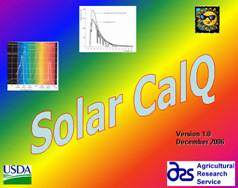 SolarCalQ – Version 1.0
Java model to simulate spectral quality at any location on the globe
SolarCalQ – Version 1.0
Java model to simulate spectral quality at any location on the globe
The purpose of this JAVA model is to simulate the spectral quality of incident solar radiation for any location on the globe, down to one minute time steps. This JAVA model is an adaptation of existing NREL (National Renewable Energy Laboratory) solar spectral quality (Bird and Riordan 1984, 1986) and solar position models (Reda and Andreas, 2003), with significant modifications that are outlined below. The solar position model of Reda and Andreas (2003) has been shown to be accurate within the time period from the year -2000 to 6000, with uncertainties of +/- 0.0003 degrees in the solar zenith and azimuth angles based on the date, time, and location on the Earth. Additional modifications that were added into the SolarCalQ model are:
- Simulation of daily maximum and minimum temperatures (from Global TempSIM),
- Minutely temperature estimates were extracted utilizing the algorithms of Cesaraccio et al. (2001),
- Original SolarCalc (Spokas and Forcella, 2006) model to produce an improved prediction in the overall intensity of the solar radiation,
- Zip Code Search to allow easier user input of latitude and longitude in the U.S.
- Empirical model for total precipitable water vapor based upon Liebe (1989) model for estimating percipitable water from surface relative humidity and surface temperatures (both of these are estimated from Global TempSIM), and
- Empirical models for ozone concentration and atmospheric optical depth (or aerosol optical depth) predictions.
The atmospheric optical depth has been linked to 3 components: Clear sky + clouds + aerosols
Spectral intensity is predicted either in integrated units (W m-2) or raw intensity units (W m-2um-1). The wavelength spacing is irregular, covering 122 wavelengths from 305 nm to 4000 nm.
User Input:
User input is handled through tabbed entry windows. An example of one of these windows is shown below. There are help screens included in the program to guide the user through the necessary input parameters.
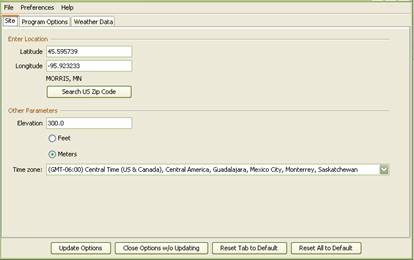
The time step is set under the “Program Options” tab. (Number of minutes per time step)
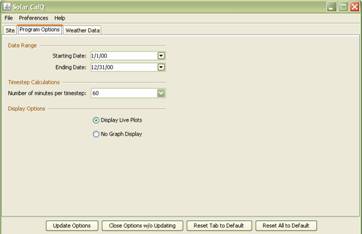
In the advanced tab (enabled under PREFERENCES) the geometry of the receiving surface (or incident surface) is described. Default is a solar tracking surface (e.g. plant leaf or flower), but any geometric arrangement can be handled by the model.
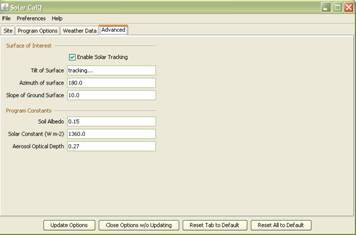
After settings have been edited select Update Options button and then Run Model from the File menu.
The output file generated (if selected under FILE) is the instantaneous output at the interval set in the program options tab.
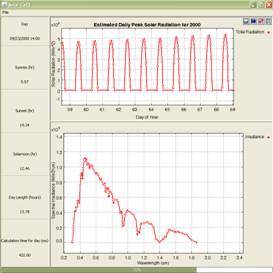
This model was developed in JAVA, is simple to use, and runs on multiple platforms (e.g. Mac, PC, Sun).
References:
Bird, R.E., and C. Riordan, 1984. Simple Solar Spectral Model for Direct and Diffuse Irradiance on Horizontal and Tilted Planes at the Earth's Surface for Cloudless Atmospheres, Technical Report No. SERI/TR-215-2436, Golden, CO: Solar Energy Research Institute.
Bird, R. E., and C.J. Riordan, 1986. Simple Solar Spectral Model for Direct and Diffuse Irradiance on Horizontal and Tilted Planes at the Earth's Surface for Cloudless Atmospheres. Journal of Climate and Applied Meteorology 25(1), 87-97.
Cesaraccio, C., D. Spano, P. Duce, and R. Zinder, 2001. An improved model for determining degree-day values from daily temperature data. Int. J. Biometeorol. 45,161-169.
Liebe, H.J., 1989. MPM - An atmospheric millimeter-wave propagation model, Int. J. Infr. Mill. Waves 10, 631-650.
Reda, I., and A. Andreas, 2003. Solar Position Algorithm for Solar Radiation Applications. 55 pp.; NREL Report No. TP-560-34302.
Download Form
Please complete the form below to track the use of the service we are providing and to help improve our product.
|
|
|
|